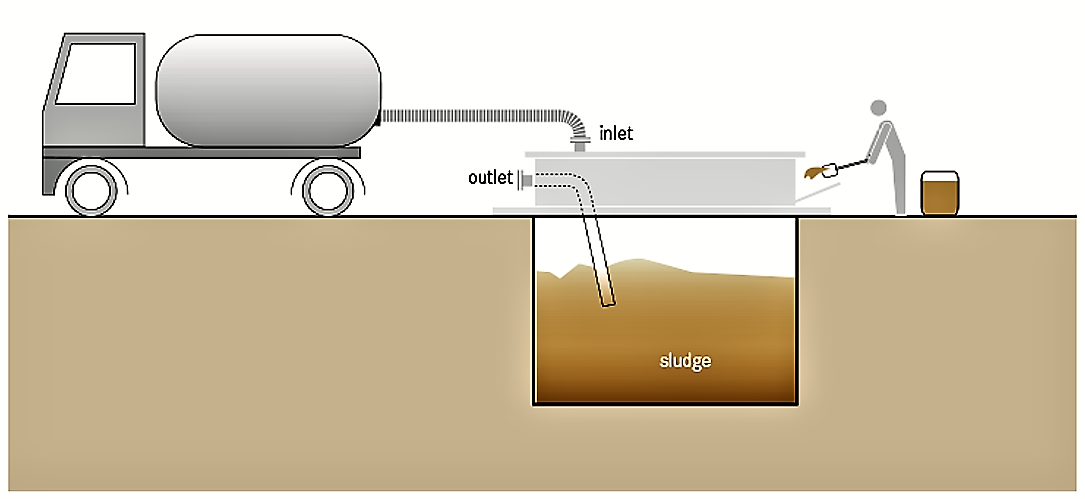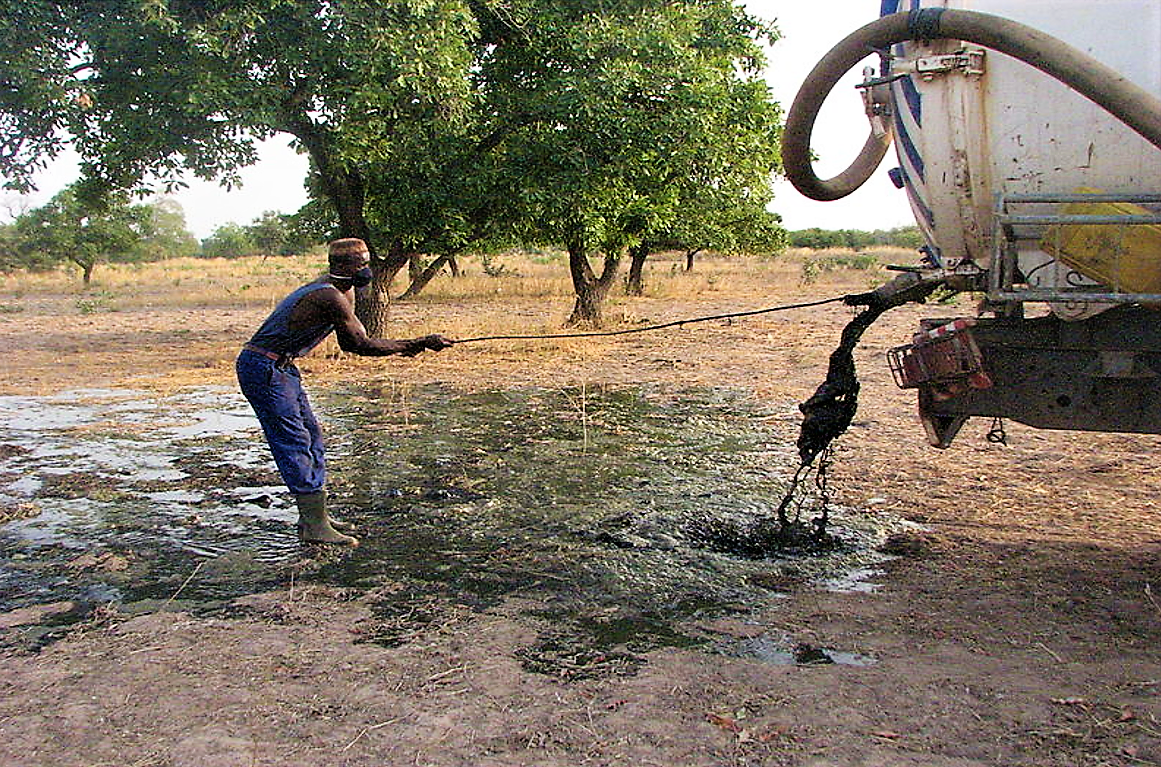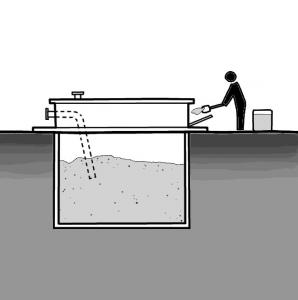Executive Summary
Sludge and septage emptied from on-site sanitation systems need to be transferred to (semi-)centralised infrastructures for further treatment. Transfer stations or underground holding tanks act as intermediate dumping points for faecal sludge and septage when it cannot be easily transported to a (Semi-) Centralized Treatment facility. A vacuum truck is required to empty transfer stations when they are full. Sewer discharge stations are similar to transfer stations, but instead of simply being a holding tank, the stations are directly connected to the sewer transporting the sludge to a (semi-) centralised treatment facility. Transfer stations reduce transport distance, may encourage more community-level emptying solutions and prevent illegal dumping. The moderate capital costs may be offset with access permits and the construction and maintenance can create local income. However, expert design and construction supervision are necessary.
| In | Out |
|---|---|
Blackwater, Faecal Sludge, Greywater, Brownwater, Urine or Yellowwater, Faeces, Non-biodegradable Wastewater |
Blackwater, Non-biodegradable Wastewater |
Introduction

Operators of human-powered or small-scale motorised sludge emptying equipment (see human-powered and motorized emptying and transport) discharge the sludge at a local transfer station rather than illegally dumping it or travelling to discharge it at a remote treatment or disposal site. When the transfer station is full, a vacuum truck empties the contents and takes the sludge to a suitable treatment facility. Municipalities or sewerage authorities may charge for permits to dump at the transfer station to offset the costs of operating and maintaining the facility.
In urban settings, transfer stations have to be carefully located, otherwise odours could become a nuisance, especially, if they are not well maintained.
Design considerations
Transfer station
A transfer station consists of a parking place for vacuum trucks or sludge carts, a connection point for discharge hoses, and a storage tank. The dumping point should be built low enough to minimize spills when labourers manually empty their sludge carts. Additionally, the transfer station should include a vent, a trash screen to remove large debris (garbage) and a washing facility for vehicles. The holding tank must be well constructed to prevent leaching and/or surface water infiltration.
Sewer discharge stations
A variation is the sewer discharge station (SDS), which is like a transfer station, but is directly connected to a conventional gravity sewer main so that it can be transported to a semi-centralised secondary treatment system. Sludge emptied into the SDS is released into the sewer main either directly or at timed intervals (e.g., by pumping) to optimize the performance of the sewer and of the wastewater treatment plant, and/or reduce peak loads. The station should be well protected and maintained to prevent random dumping into the sewer and to ensure the safety of the users. As for the transfer station (see above), expert design and construction supervising are required.
Transfer stations can be equipped with digital data recording devices to track quantity, input type and origin, as well as collect data about the individuals who dump there. In this way, the operator can collect detailed information and more accurately plan and adapt to differing loads.
The system for issuing permits or charging access fees must be carefully designed so that those who most need the service are not excluded because of high costs, while still generating enough income to sustainably operate and maintain the transfer stations.
Health aspects/acceptance
Transfer stations have the potential to significantly increase the health of a community by providing an inexpensive, local solution for faecal sludge and septage disposal. By providing a transfer station, independent or small-scale service providers are no longer forced to illegally dump sludge, and homeowners are more motivated to empty their pits. When pits are regularly emptied and illegal dumping is minimized, the overall health of a community can be significantly improved. The location must be carefully chosen to maximize efficiency and minimize odours and problems to nearby residents.
Costs considerations
The moderate capital costs may be offset with access permits and the construction and maintenance can create local income. The system for issuing permits or charging access fees must be carefully designed so that those who most need the service are not excluded because of high costs, while still generating enough income to be sustainable and well-maintained. Also the costs for maintenance, observation and operation of the facility must be considered.

Operation & maintenance
Screens must be frequently cleaned to ensure a constant flow and prevent back-ups. Sand, grit and consolidated sludge must also be periodically removed from the holding tank. There should be a well-organized system to empty the transfer station; if the holding tank fills up and overflows, it is no better than an overflowing pit. It is important, that there is a person or organisation responsible who organises the logistic of the facility.
The pad and loading area should be regularly cleaned to minimize odours, flies and other vectors from becoming nuisances. It should be ensured that the sludge from transfer or sewer discharge stations is treated in an appropriate secondary treatment facility (e.g. planted or unplanted drying beds, anaerobic digestion or composting large scale) and not be illegally dumped. Also, the sewers need to be inspected periodically to avoid blockages.
At a glance
| Working principle | Sludge from manually emptied pits or septic tanks can be stored in tanks. These must be emptied regularly either by a vacuum truck (transfer station) or it is connected to a main sewer line (sewer discharge station). |
| Capacity/adequacy | Especially appropriate for dense, urban areas where there is no alternative discharge point. But a sewer system must exist and an operating team is needed to organise emptying, maintenance and cleaning of the facility. |
| Performance | The sludge is collected in a closed tank. This avoids pathogen spreading and illegal dumping. |
| Costs | Moderate capital and operating costs; can be offset with access permits. |
| Self-help compatibility | Expert design and construction supervising are required. Can be constructed with locally available material. |
| O&M | Racks (screens) must be cleaned frequently to ensure a constant flow and prevent backups. Sand and grit must also be periodically removed from the holding tank. When the transfer station is filled up, it must be emptied by a vacuum truck and transported to a treatment facility. |
| Reliability | If well maintained and constructed, high. |
| Main strength | Reduces transport distance and may encourage more community-level emptying solutions. |
| Main weakness | Sludge requires secondary treatment and/or appropriate discharge; Requires an institutional framework which cares about access fees, connection to sewers or regular emptying and maintenance |
Transfer stations are appropriate for dense, urban areas where there are no alternative discharge points (e.g. settling and thickening ponds or drying beds) for faecal sludge. Establishing multiple transfer stations may help to reduce the incidence of illegal sludge dumping and promote the emptying market. For a sewer discharge station, a connection to a sewer main must be possible.
Transfer stations are especially adequate where small-scale sludge emptying takes place (i.e. where sludge is manually removed from pits and septic tanks . In big cities, they can reduce the costs incurred by truck operators by decreasing transport distances and waiting times in traffic jams. Local service providers can discharge sludge at transfer stations during the day, while large trucks can empty the tanks and go to the treatment plant at night when traffic is light.
Transfer stations should be located where they are easily accessible, convenient, and easy to use. Depending on their maintenance, odours could become a problem to local residents. However, the benefits gained from them compared to open-air illegal dumping greatly offset any nuisances.
A proper legal and institutional framework is required as well in order to strengthen enforcement bodies to illegal dumping and to ensure operation and maintenance.
Accra Sewerage Improvement Project (ASIP)
This report describes the Accra Sewerage Improvement Project (ASIP) that will provide two new major sewage treatment plants at Densu Delta and Legon to cover the 2020 horizon. The project will comprise the six compontents: (A) Treatment Plants and Pumping Stations, (B) Sewerage Networks and Sanitation Facilities, (C) Environmental Measures, (D) Institutional Strengthening, (E) Engineering Services, and (F) Project Management.
AFRICAN DEVELOPMENT FUND (2005): Accra Sewerage Improvement Project (ASIP). (= Appraisal Report ). Abidjan: Infrastructure Department Central and West Regions URL [Accessed: 30.07.2014]Faecal Sludge in Accra, Ghana: Problems of Urban Provision
Urban on-site sanitation services present challenges for emptying, transporting, disposing and treating faecal waste. Transfer stations can be used by household-level emptiers to safely dispose of faecal sludge, but they rarely exist. Accra's use of transfer stations has provided an opportunity to research their functioning, as part of broader faecal sludge management arrangements. The paper discusses the benefits offered by use of transfer stations, as well as reasons currently limiting their operation. The paper concludes that correct use of transfer stations can provide improvements for existing faecal sludge management and reduce indiscriminate dumping.
BOOT, N. L. ; SCOTT, R. E. (2009): Faecal Sludge in Accra, Ghana: Problems of Urban Provision. In: Water Science Technology: Volume 60 , 623-631.Business Analysis of Fecal Sludge Management: Emptying and Transportation Services in Africa and Asia
This study maps the urban sanitation situation and assesses business and operating models for fecal sludge management in 30 cities across 10 countries in Africa and Asia, specifically focussing on the extraction and transportation market segments.
CHOWDHRY, S. KONE, D. (2012): Business Analysis of Fecal Sludge Management: Emptying and Transportation Services in Africa and Asia. Seattle: Bill & Melinda Gates Foundation URL [Accessed: 22.07.2014]Faecal Sludge Management
This is the first book to compile the current state of knowledge on faecal sludge management. It addresses the organization of the entire faecal sludge management service chain, from the collection and transport of sludge, to the current state of knowledge of treatment options, and the final end use or disposal of treated sludge. It presents an integrated approach that brings together technology, management, and planning, based on Sandec’s 20 years of experience in the field. It also discusses important factors to consider when evaluating and upscaling new treatment technology options. The book is designed for undergraduate and graduate students, engineers, and practitioners in the field who have some basic knowledge of environmental and/or wastewater engineering.
STRANDE, L. ; RONTELTAP, M. ; BRDJANOVIC, D. (2014): Faecal Sludge Management. Systems Approach for Implementation and Operation. London: IWA Publishing URL [Accessed: 16.07.2014]Compendium of Sanitation Systems and Technologies. 2nd Revised Edition
This compendium gives a systematic overview on different sanitation systems and technologies and describes a wide range of available low-cost sanitation technologies.
TILLEY, E., ULRICH L., LÜTHI, C., REYMOND P. and ZURBRÜGG C. (2014): Compendium of Sanitation Systems and Technologies. 2nd Revised Edition. Duebendorf, Switzerland: Swiss Federal Institute of Aquatic Science and Technology (Eawag) URL [Accessed: 03.05.2023] PDFGuide to Septage Treatment and Disposal
The purpose of this guide is to present practical information on the handling, treatment, and disposal of septage in a concise, recommendations-oriented format for easy use by administrators of waste management programs, septage haulers, and managers or operators of septage handling facilities. The guide is not intended to provide detailed engineering design information.
U.S. EPA (1994): Guide to Septage Treatment and Disposal. (= EPA/625/R-94/002 ). Washingtion D.C.: United States Environmental Protection Agency, Office of Research and Development URL [Accessed: 30.05.2019]Compendium of Sanitation Systems and Technologies (Arabic)
This is the Arabic version of the Compendium of Sanitation Systems and Technologies. The Compendium gives a systematic overview on different sanitation systems and technologies and describes a wide range of available low-cost sanitation technologies.
TILLEY, E. ULRICH, L. LUETHI, C. REYMOND, P. SCHERTENLEIB, R. ZURBRUEGG, C. (2014): Compendium of Sanitation Systems and Technologies (Arabic). 2nd Revised Edition. Duebendorf, Switzerland: Swiss Federal Institute of Aquatic Science and Technology (Eawag) PDFFaecal Sludge Management
This is the first book to compile the current state of knowledge on faecal sludge management. It addresses the organization of the entire faecal sludge management service chain, from the collection and transport of sludge, to the current state of knowledge of treatment options, and the final end use or disposal of treated sludge. It presents an integrated approach that brings together technology, management, and planning, based on Sandec’s 20 years of experience in the field. It also discusses important factors to consider when evaluating and upscaling new treatment technology options. The book is designed for undergraduate and graduate students, engineers, and practitioners in the field who have some basic knowledge of environmental and/or wastewater engineering.
STRANDE, L. ; RONTELTAP, M. ; BRDJANOVIC, D. (2014): Faecal Sludge Management. Systems Approach for Implementation and Operation. London: IWA Publishing URL [Accessed: 16.07.2014]Liquid Industrial Waste Holding Tanks
This is a technical paper about liquid waste holding tanks and their construction.
GRANHOLM, J.M. CHESTER, S.E. (2007): Liquid Industrial Waste Holding Tanks. Lansing: Michigan Department Of Environmental Qualityhttp://michigan.gov/documents/deq/deq-ess-p2tas-liwholdingtank_207979_7.pdf URL [Accessed: 24.01.2011]Faecal Sludge Management. Lecture Notes
This module pays special attention to the haulage, treatment and reuse or disposal of faecal sludge. It covers both technical and non-technical (socio-cultural, economic, political etc.) aspects and provides practical information on design, financing and planning of faecal sludge treatment plants.
EAWAG/SANDEC (2008): Faecal Sludge Management. Lecture Notes. (= Sandec Training Tool 1.0, Module 5 ). Duebendorf: Swiss Federal Institute of Aquatic Science (EAWAG), Department of Water and Sanitation in Developing Countries (SANDEC) URL [Accessed: 23.05.2012]Towards an Improved Faecal Sludge Management (FSM)
More than two billion urban dwellers in developing countries use on-site sanitation facilities such as pit latrines, septic tanks and aqua privies for excreta and wastewater disposal. Since on-site sanitation installations will serve the growing urban populations in developing countries for decades to come, increasing faecal sludge quantities will have to be managed. Proper faecal sludge management (FSM) is the important link missing in integrated urban sanitation upgrading efforts.
KONE, D. STRAUSS, M. SAYWELL, D. (2007): Towards an Improved Faecal Sludge Management (FSM). Duebendorf: EAWAG/SANDEC URL [Accessed: 15.12.2010]Smart Sanitation Solutions
Smart Sanitation Solutions presents examples of low-cost household and community-based sanitation solutions that have proven effective and affordable. A wide range of innovative technologies for toilets, collection, transportation, treatment and use of sanitation products that have already helped thousands of poor families to improve their lives is illustrated.
NWP (2006): Smart Sanitation Solutions. Examples of innovative, low-cost technologies for toilets, collection, transportation, treatment and use of sanitation products. (= Smart water solutions ). Amsterdam: Netherlands Water Partnership (NWP) URL [Accessed: 09.05.2019]Compendium of Sanitation Systems and Technologies
This compendium gives a systematic overview on different sanitation systems and technologies and describes a wide range of available low-cost sanitation technologies.
TILLEY, E., LUETHI, C., MOREL, A., ZURBRUEGG, C. and SCHERTENLEIB, R. (2008): Compendium of Sanitation Systems and Technologies. Duebendorf, Switzerland: Swiss Federal Institute of Aquatic Science and Technology (EAWAG) and Water Supply and Sanitation Collaborative Council (WSSCC) URL [Accessed: 15.02.2010] PDFA Guide to the Development of On-site Sanitation
The publication presents appropriate technologies for sanitation and highlights socio-economic aspects of planning and implementing. Emphasis is given to household-level sanitation improvements for urban areas, as well as rural areas and small communities. Background information on sanitation, in-depth technical information on the design, construction, operation and maintenance and project planning and development processes involved in projects and programmes complement the book.
WHO (1992): A Guide to the Development of On-site Sanitation. Geneva: World Health Organisation (WHO) URL [Accessed: 14.04.2010]Accra Sewerage Improvement Project (ASIP)
This report describes the Accra Sewerage Improvement Project (ASIP) that will provide two new major sewage treatment plants at Densu Delta and Legon to cover the 2020 horizon. The project will comprise the six compontents: (A) Treatment Plants and Pumping Stations, (B) Sewerage Networks and Sanitation Facilities, (C) Environmental Measures, (D) Institutional Strengthening, (E) Engineering Services, and (F) Project Management.
AFRICAN DEVELOPMENT FUND (2005): Accra Sewerage Improvement Project (ASIP). (= Appraisal Report ). Abidjan: Infrastructure Department Central and West Regions URL [Accessed: 30.07.2014]Faecal Sludge Management in Accra, Ghana: Strengthening Links in the Chain
This case study is about a research in Accra (Ghana), which has identified important constraints to achieving an efficient and fully functioning faecal sludge management (FSM) chain, with consequences for both people and the environment. Opportunities to improve the institutional and operating environment are identified, particularly affecting engagement between the public and private sector and civil society.
BOOT, N. SCOTT, R. (2008): Faecal Sludge Management in Accra, Ghana: Strengthening Links in the Chain. Loughborough: Water, Engineering and Development Centre (WEDC) URL [Accessed: 24.01.2011]Business Analysis of Fecal Sludge Management: Emptying and Transportation Services in Africa and Asia
This study maps the urban sanitation situation and assesses business and operating models for fecal sludge management in 30 cities across 10 countries in Africa and Asia, specifically focussing on the extraction and transportation market segments.
CHOWDHRY, S. KONE, D. (2012): Business Analysis of Fecal Sludge Management: Emptying and Transportation Services in Africa and Asia. Seattle: Bill & Melinda Gates Foundation URL [Accessed: 22.07.2014]Guide to Septage Treatment and Disposal
The purpose of this guide is to present practical information on the handling, treatment, and disposal of septage in a concise, recommendations-oriented format for easy use by administrators of waste management programs, septage haulers, and managers or operators of septage handling facilities. The guide is not intended to provide detailed engineering design information.
U.S. EPA (1994): Guide to Septage Treatment and Disposal. (= EPA/625/R-94/002 ). Washingtion D.C.: United States Environmental Protection Agency, Office of Research and Development URL [Accessed: 30.05.2019]Faecal Sludge Management. Pdf Presentation
A presentation about faecal sludge management in developing countries.
EAWAG ; SANDEC (2008): Faecal Sludge Management. Pdf Presentation. (= Sandec Training Tool 1.0, Module 5 ). Duebendorf: Swiss Federal Institute of Aquatic Science (Eawag), Department of Water and Sanitation in Developing Countries (Sandec) URL [Accessed: 23.05.2012]
